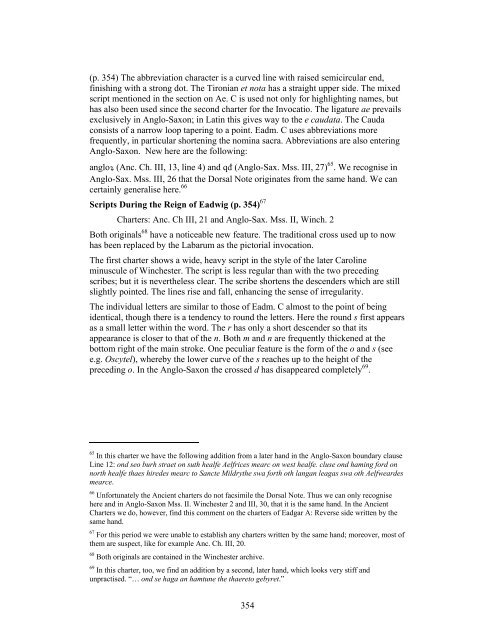Provisional Drogereit pdf
Provisional Drogereit pdf
Provisional Drogereit pdf
Create successful ePaper yourself
Turn your PDF publications into a flip-book with our unique Google optimized e-Paper software.
(p. 354) The abbreviation character is a curved line with raised semicircular end,<br />
finishing with a strong dot. The Tironian et nota has a straight upper side. The mixed<br />
script mentioned in the section on Ae. C is used not only for highlighting names, but<br />
has also been used since the second charter for the Invocatio. The ligature ae prevails<br />
exclusively in Anglo-Saxon; in Latin this gives way to the e caudata. The Cauda<br />
consists of a narrow loop tapering to a point. Eadm. C uses abbreviations more<br />
frequently, in particular shortening the nomina sacra. Abbreviations are also entering<br />
Anglo-Saxon. New here are the following:<br />
anglo (Anc. Ch. III, 13, line 4) and qđ (Anglo-Sax. Mss. III, 27) 65 . We recognise in<br />
Anglo-Sax. Mss. III, 26 that the Dorsal Note originates from the same hand. We can<br />
certainly generalise here. 66<br />
Scripts During the Reign of Eadwig (p. 354) 67<br />
Charters: Anc. Ch III, 21 and Anglo-Sax. Mss. II, Winch. 2<br />
Both originals 68 have a noticeable new feature. The traditional cross used up to now<br />
has been replaced by the Labarum as the pictorial invocation.<br />
The first charter shows a wide, heavy script in the style of the later Caroline<br />
minuscule of Winchester. The script is less regular than with the two preceding<br />
scribes; but it is nevertheless clear. The scribe shortens the descenders which are still<br />
slightly pointed. The lines rise and fall, enhancing the sense of irregularity.<br />
The individual letters are similar to those of Eadm. C almost to the point of being<br />
identical, though there is a tendency to round the letters. Here the round s first appears<br />
as a small letter within the word. The r has only a short descender so that its<br />
appearance is closer to that of the n. Both m and n are frequently thickened at the<br />
bottom right of the main stroke. One peculiar feature is the form of the o and s (see<br />
e.g. Oscytel), whereby the lower curve of the s reaches up to the height of the<br />
preceding o. In the Anglo-Saxon the crossed d has disappeared completely 69 .<br />
65 In this charter we have the following addition from a later hand in the Anglo-Saxon boundary clause<br />
Line 12: ond seo burh straet on suth healfe Aelfrices mearc on west healfe. cluse ond haming ford on<br />
north healfe thaes hiredes mearc to Sancte Mildrythe swa forth oth langan leagas swa oth Aelfweardes<br />
mearce.<br />
66 Unfortunately the Ancient charters do not facsimile the Dorsal Note. Thus we can only recognise<br />
here and in Anglo-Saxon Mss. II. Winchester 2 and III, 30, that it is the same hand. In the Ancient<br />
Charters we do, however, find this comment on the charters of Eadgar A: Reverse side written by the<br />
same hand.<br />
67 For this period we were unable to establish any charters written by the same hand; moreover, most of<br />
them are suspect, like for example Anc. Ch. III, 20.<br />
68 Both originals are contained in the Winchester archive.<br />
69 In this charter, too, we find an addition by a second, later hand, which looks very stiff and<br />
unpractised. “… ond se haga an hamtune the thaereto gebyret.”<br />
354
















